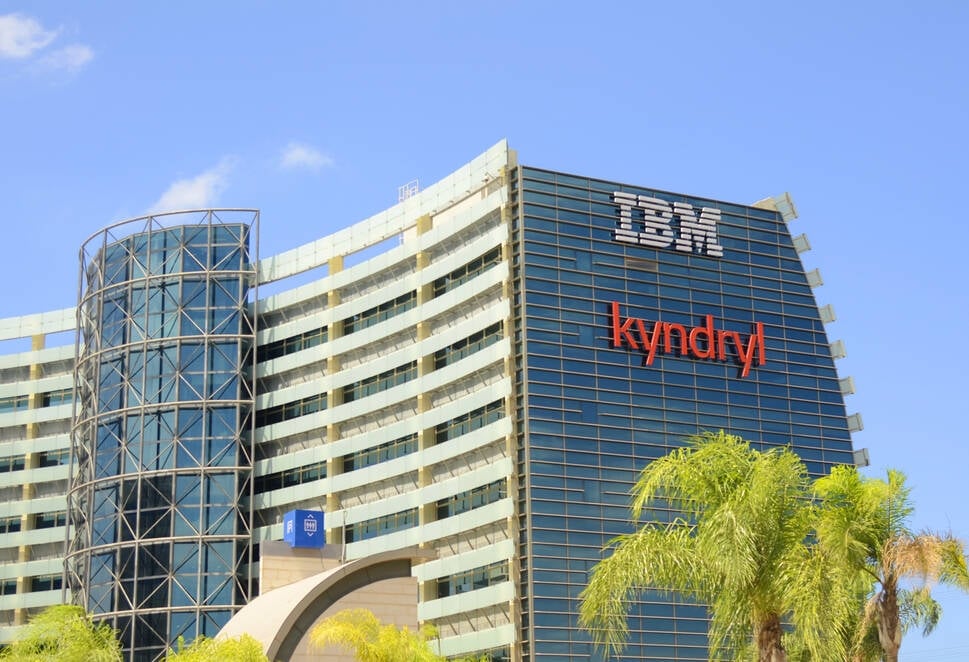Bussiness
Kyndryl insiders claim new business is scarce

Special report Kyndryl, the managed infrastructure services business spun out of IBM in 2021, earlier this month repeated its somewhat glum prediction that its revenue will shrink by two to four percent for its fiscal 2025, the year ending March 31.
That “growth” would put the IT giant’s annual revenue at somewhere between $15.2 to $15.5 billion.
That rate of decline is a bit better than what we saw in Q1 FY2025, the three months to June 30, 2024, and the following quarter, which saw constant-currency revenue slippage of eight percent and seven percent, respectively. But it’s consistent with the previous four years, in which revenue fell from $18.65 billion in FY2021 to $17.20 billion in FY2022 to $17 billion in FY2023 to $16.1 billion in FY2024.
But in Q4 FY2025, Kyndryl anticipates positive revenue growth in constant-currency compared to the same quarter a year prior. It attributes that projection in part to unspecified “signings growth.”
Former employees, however, have expressed doubt that the reported signings amount to new business.
We heard last month from several laid-off Kyndryl employees that the outfit has not been winning new IT service contracts and has been laying workers off as a result.
There wasn’t an ounce of new business as far as I knew, and they were only losing accounts
The Register has since heard the same opinion from others familiar with the biz, who also report a scarcity of new customers and ongoing attrition, as employees are “benched” for lack of association with a billable project and then laid off amid scarce internal opportunities.
“There wasn’t an ounce of new business as far as I knew, and they were only losing accounts,” a recently laid-off employee we’ll call “Kai” told us.
Among those we spoke with, there’s skepticism about Kyndryl’s potential return to positive revenue growth and the impact of its consulting business.
When the corporation was spun out of IBM, it inherited Big Blue’s outsourcing work. Kyndryl thus has been fulfilling multi-year managed service contracts for various customers, yet many of these IT deals are either barely profitable or unprofitable.
Kyndryl has been trying to grow its separate consulting business, where it helps companies transform legacy operations by moving some or all of their IT services to cloud hyperscalers including Amazon, Google, and Microsoft. Consulting arrangements tend to have better profit margins but are also shorter-term – they often represent a one-time transaction rather than recurring revenue.
“They are trying to become a consulting-led business,” said a departing Kyndryl employee we’ll call “Noah.” “But they found out that’s really not totally sustainable by itself. They actually have to do the old-style outsourcing business, too.”
That figures
Assessing the success of the consulting push isn’t easy because Kyndryl doesn’t provide much detail in its financial reporting. Noah explained that Kyndryl Consult doesn’t run a profit and loss statement (P&L) by country.
“So when they say the revenue for consulting is growing … there’s nothing to back it up,” Noah claimed.
We’re told Kyndryl is just taking from managed service accounts (its outsourcing accounts) and counting that as consulting work.
“They’re just taking it from the left pocket to the right pocket and saying, ‘Oh, that’s consulting business,'” Noah explained.
To fix unprofitable contracts, we’re told, Kyndryl has shifted the IT transformation activities and projects that used to occur within a customer’s outsourcing account – and for which Kyndryl would be accountable if things fell short – to consulting engagements that occur outside the account.
And Kyndryl isn’t on the hook in the same way if the consulting-led transformation doesn’t work since the customer participates in what’s called a co-design process. In these projects, Kyndryl works with the customer to develop a solution, rather than delivering a pre-defined one.
“They call it co-design,” Noah explained. “They say, ‘we now co-design with our customers,’ which means they just shift the risk.”
Where Kyndryl used to offer a fixed price for a transformation project within a managed service contract, we’re told the current goal is to classify transformation revenue as a consulting project that gets co-designed with the customer.
If they get it wrong, they just make more revenue
“If they get it wrong, they just make more revenue,” said Noah. “They just [change projects]. There’s no fixed price risk anymore. This is the problem that IBM had – they would sell a service that didn’t work, and then they’d have to fix it at their own cost.”
Doubts were also voiced about the composition of revenue, “a record $5.6 billion, representing a year-over-year increase of 132 percent,” the firm reported for Q2 FY2025.
Noah observed that Kyndryl has not said how much of this revenue is coming from new customers, or “new logos.”
“It’s renewals,” we’re told. “It’s the same business.”
During Kyndryl’s recent earnings call, Isaac Sellhausen, equity analyst for Oppenheimer & Co., asked this question.
“Maybe if you’d be able to provide some higher-level commentary [on] what you’re seeing for growth between new logos and existing customers and then secondly, maybe how those margins on those consult signings compared to managed services and some of the other work,” Sellhausen queried.
The responses that follow from CFO David Wyshner and CEO Martin Schroeter do not directly address the question raised by Sellhausen, who declined to comment on this story, and fail to clarify what percentage of revenue is coming from new customers.
What they’re doing is they’re sacrificing some outsourcing business where they might have done some on-prem work. And they’ll run a consulting project to move them to the cloud
“What they’re doing is they’re sacrificing some outsourcing business where they might have done some on-prem work,” our source said. “And they’ll run a consulting project to move them to the cloud. And they’ll say, we just did $4 million of new consulting business, but they just lost a $50 million outsourcing deal.
“Once it’s hosted on Amazon, they’re not getting the hosting fees anymore. So they’re just converting the business from outsourcing. They’ve got this transactional consulting business that they’re winding up, but they’re losing that annuity, that five-year outsourcing deal. And that’s what’s going on.”
To hear Kyndryl tell it, things are going swimmingly. “We signed 10 deals of more than $100 million in the quarter, including our largest deal as an independent company, a scope expansion that will generate more than $2 billion of revenue over the next five years,” Schroeter said on the call – not specifying what portion of that business is new as opposed to renegotiation of a prior deal.
Florida men
Those who have worked for the biz tell a different tale. An individual we’ll call “Rowan” said the UK wing apparently had “the worst set of Q1 figures ever, either when it was part of IBM or after the split,” raising some questions over performance.
Noah added, “I am aware that they’re not meeting their sales targets. There was a big executive conference in Miami in October, and the whole thing was on sales.” The meeting, we’re told, led to a new incentive plan for salespeople focused on growth.
The Register asked Kyndryl twice to address claims made by our sources and to explain how the company anticipates growing revenue amid the alleged lack of business.
We’ve not heard back.
Kyndryl has attributed recent revenue declines to “no-margin and low-margin third-party content in customer contracts” inherited from the IBM spinout.
Rowan said Kyndryl relies heavily on a dozen or so major contacts, such as Lloyds. “There are people on that account who are 100 percent billed but do nothing,” we’re told. “They just go after huge signings and price themselves out of the market on the real money earners.”
Noah said it’s fewer than a dozen, and that Kyndryl is expected to lose a significant account outside the US this year. It’s further claimed Kyndryl is likely to count the termination assistance it provides to its departing client as revenue.
Another complication is Kyndryl’s mainframe business, which came from IBM. “Nobody has as many mainframes as Kyndryl does,” said Noah. “That’s probably the only thing we’re big at.”
The problem is that Kyndryl’s mainframe software deal with IBM ends this year. “We basically will go back to published rates,” Noah explained. “So right now, we don’t pay published rates on software in IBM mainframes. And IBM mainframe software is really expensive. It’s the biggest cost in the company.”
Looking ahead, we’re told, Kyndryl will have to pay quoted rates, adjusted by whatever discount ends up being negotiated. But it’s unlikely to be as cheap as it is now. So Kyndryl is trying to get customers off mainframes and into the cloud.
“What they’re not saying in their risk statement is the risk of the IBM software cost next year,” Noah said.
On the November 6, 2024 financial call, Schroeter did mention new customers in the context of Kyndryl Bridge, an analytics service launched in September 2022. “[W]e’re also beginning to add more new logos where Kyndryl Bridge is at the core of our service delivery across multiple platforms involving one or more hyperscalers,” he said, without providing revenue specifics.
Noah disputes the claims about customer adoption of Bridge. “They keep saying they have thousands of accounts using it,” we’re told. “They don’t. They’re overselling Bridge and they’re creating a technical debt that’s enormous. It’s all bespoke. They’re tweaking the heck out of it. They’re trying to get customers pregnant on it. And then customers can’t get off. Kyndryl needs it so they can do a single-pane delivery service. But customers don’t.”
A former employee we’ll call “James” said, “There was a huge push to get existing customers onto Bridge because that’s a product they developed. All it is is an analytics product. People can look and see how things are going with their M365 installation. And they’re charging a heckuva lot of money for this.”
If they are growing, it’s fictitious growth. Failing companies, what they start doing is reducing the payroll and saying they’re growing. That’s what’s happening at Kyndryl right now
James theorized that Kyndryl is trying to make itself attractive as an acquisition target.
“Right now, they’re not going to survive on their own,” James argued. “Everyone is having a problem right now. The US market is tanking. It’s a bloodbath right now. Every company is trying to penny-pinch everything they can to stay alive. There’s no growth, they’re trying to hold on to customers they have and some of those leaving.
“If they are growing, it’s fictitious growth. Failing companies, what they start doing is reducing the payroll and saying they’re growing. That’s what’s happening at Kyndryl right now.”
It does appear that Kyndryl is continuing to reduce its payroll, and is managing to make the process more difficult for those being let go.
“Essentially, the moment they gave me my two week notice, they removed all benefit information from my Workday,” said Kai, in reference to the HR platform used by the IT giant. “Basically [that made] it impossible for us to cross reference or verify that our payouts were accurate. It also cleared out any information regarding projects and accomplishments/certifications, so I had nothing to show for X years of work.”
Kai recounted being aware of another employee being let go who also lost access to Workday data.
Surprisingly, among those being let go whom Kai was aware of, many were in the early stages of their career – possibly a response to past accusations of age discrimination.
“I was told specifically that I was being let go because my age, title, and level in the company met a certain metric,” Kai said. “I was in band X out of 10 in the company, tens being execs like Martin Schroeter. I worked damn hard to get myself there and it feels like I worked myself out of the job.
“I think the earlier you are in your career, the greater your potential for earning more later in your career. But mind you, the executive team has been taking home record bonuses year after year.”
Margins
Jamie Friedman, senior FinTech and IT services research analyst with Susquehanna International Group, told The Register that from a financial point of view, the concerns raised by our sources aren’t necessarily antithetical to an investment outcome.
“I don’t think that Kyndryl has claimed to generally be pursuing or winning new logos,” he said.
Friedman said Kyndryl inherited a lot of deals from IBM that had dilutive economics – they cost more to service than Kyndryl could bill. So repricing or losing those deals would improve the firm’s margins.
“Right now, it’s really about trying to fix what they have,” he said.
Essentially, many of the managed service contracts Kyndryl inherited from IBM rely on IBM infrastructure, Friedman explained, and as clients ponder their future roadmap, some portion of them are going to look to move from IBM infrastructure to the open architecture of the cloud.
“The problem is that in those managed service contracts, when the client leaves IBM, it’s leaving Kyndryl, and the only way that Kyndryl can touch it is through the migration to another infrastructure provider,” Friedman explained.
Thus, he suggests, it makes sense to engage on a consulting basis rather than cut ties completely.
Of course, if business is not growing, another way to make the numbers look better is to cut expenses, namely staff.
Friedman thinks Kyndryl’s diminishing headcount – currently about 80,000 – is still too high.
“If you look at the company with the revenue in the numerator and the headcount in the denominator, their revenue per head is too low,” he said. “And if you look at their cost of goods divided by their headcount, their expense structure is high. And that’s because they’re so onshore … It’s very hard to win new contracts or even keep your old contracts if your costs are too high.”
In its Q4 FY2024 report, Kyndryl said it expected “$100 million in workforce rebalancing charges” in FY2025. The company took $39 million in workforce rebalancing charges in Q2 FY2025 and $36 million in Q1.
At this rate, Kyndryl is on track to shed enough employees to reach its projected target by the end of Q3. ®








